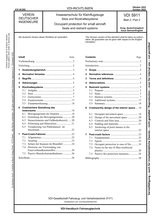Standards Worldwide
Standards Worldwide
Phone +49 30 58885700-07

Technical rule [CURRENT]
VDI 5911 Blatt 2:2022-10
Occupant protection for small aircraft - Seats and restraint systems
- German title
- Insassenschutz für Kleinflugzeuge - Sitze und Rückhaltesysteme
- Publication date
- 2022-10
- Original language
- German, English
- Pages
- 28
- Publication date
- 2022-10
- Original language
- German, English
- Pages
- 28
Product information on this site:
Quick delivery via download or delivery service
Buy securely with a credit card or pay upon receipt of invoice
All transactions are encrypted
Short description
Accident statistics show that light aircraft and gliders have an unusual frequency of accidents. Among other things, this indicates that most of the accidents occur in the critical phases of take-off and landing, occurring predominantly at low altitudes and at low crash speeds. It is noticeable that many accidents involving air sports equipment are fatal. Because of the increase in the number of general aviation aircraft in operation, an increase in safety is becoming increasingly important. With the spread of fiber-optic aircraft, several approaches have been taken to investigate and optimize these structures with regard to their complex failure behaviour. Existing approaches must be checked in order to develop and test concepts for the different types of aircraft. From these investigations, design guidelines and standards for improved occupant protection should be derived. This will allow aircraft manufacturers to make their aircraft safer so that their products will be more widely accepted by customers. This standard provides assistance to designers of small aircraft in designing an aircraft to be developed or modifications to such with the greatest possible accident suitability. It shows which influences favour or disadvantage accident suitability. Possible methods and technologies for an accident-capable design are mentioned. This standard deals with the basic principles of restraint systems, cockpit design and post-crash factors. The integrity of the structure is dealt with in VDI 5911 Part 1.
Content
ICS
49.095
Also available in
Loading recommended items...
Loading recommended items...
Loading recommended items...
